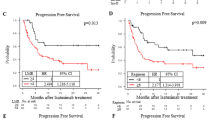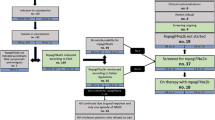Purpose of Review
Based on personal experiences, recommendations for physicians treating patients with multiple myeloma (MM) in low- and middle-income countries (LMICs) are proposed.
Recommendations
(1) Implement strategies to keep the patient in the best possible condition for the longest time, in addition to focusing on ways to avoid financial toxicity; (2) if lenalidomide is unavailable, start treatment with thalidomide and dexamethasone, include, if possible, bortezomib; (3) conduct an outpatient-based autologous stem cell transplantation (ASCT) in all eligible patients; (4) use thalidomide as post-ASCT maintenance treatment if lenalidomide is unavailable for the standard risk patients; (5) monitor monoclonal proteins with serum protein electrophoresis and free light chain measurements; (6) employ novel drugs in cases of relapsed or refractory disease; and (7) do not forget supportive therapy.
Summary
The therapeutic recommendations to treat patients with MM are somewhat different for physicians working in LMICs, compared with those treating patients in high-income countries. These are relevant since more than 50% of the inhabitants of the world live in LMICs, thus indicating that the vast majority of patients with MM are being treated in resource-constrained settings. As time goes by, physicians may acquire the ability to analyze and express their feelings and experiences about topics in the practice of medicine in which they could have learned lessons (1). Since 1980, we have been treating patients with multiple myeloma (MM); to date, we have been personally involved in the study and treatment of more than 300 patients with this disease (2). Having gained experience dealing with MM patients in underprivileged circumstances, such as those prevailing in our country: México, having explored different ideas, treatments, and methods, and being aware of the financial implications which may impact our selection of therapeutic strategies and recommendations, we felt that it was appropriate to share in this article some of these ideas with practitioners around the world who are involved in the treatment of patients with MM in low- and middle-income countries (LMICs).
Similar content being viewed by others
References
Papers of particular interest, published recently, have been highlighted as: • Of importance importance
Ramsenthaler C, Kane P, Gao W, Siegert RJ, Edmonds PM, Schey SA, et al. Prevalence of symptoms in patients with multiple myeloma: a systematic review and meta-analysis. Eur J Haematol. 2016;97:416–29.
Acquah ME, Hsing AW, McGuire V, Wang S, Birmann B, Dei-Adomakoh Y. Presentation and survival of multiple myeloma patients in Ghana: a review of 169 cases. Ghana Med J. 2019;53:52–8.
Lee N, Moon S, Lee J, Park H, et al. Discrepancies between the percentage of plasma cells in bone marrow aspiration and BM biopsy: impact on the revised IMWG diagnostic criteria of multiple. Blood Cancer J. 2017;7:530.
Rajkumar SV, Kumar S. Multiple myeloma: diagnosis and treatment. Mayo Clin Proc. 2016;91:101–19.
Diamond BT, Rustad E, Maclachlan K, Thoren K, Ho C, Roshal M, et al. Defining the undetectable: The current landscape of minimal residual disease assessment in multiple myeloma and goals for future clarity. Blood Rev. 2020;100732.
Lambert L, Ourednicek P, Meckova Z, Gavelli G, Strau J. Whole-body low-dose computed tomography in multiple myeloma staging: superior diagnostic performance in the detection of bone lesions, vertebral compression. Oncol Lett. 2017;13:2490–4.
Jamet B, Bailly C, Carlier T, Michaud A-V, Touzeau C, Moreau P, et al. FDG PET in multiple myeloma. In: Molecular imaging in multiple myeloma. Am J Nucl Med Mol Imaging. 2019;8:421–7.
Greipp PR, Miguel JS, Durie BGM, Crowley JJ, Barlogie B, Bladé J, et al. International staging system for multiple myeloma. J Clin Oncol. 2005;23:3412–20.
D’Amato RJ, Loughnan MS, Flynn E, Folkman J. Thalidomide is an inhibitor of angiogenesis. Proc Natl Acad Sci U S A. 1994;26(91):4082–5.
Singhal S, Mehta J, Desikan R, Ayers D, Roberson P, Eddlemon P, et al. Antitumor activity of thalidomide in refractory multiple myeloma. N Engl J Med. 1999;18:1565–71.
Dimopoulos MA, Anagnostopoulos A, Weber D. Treatment of plasma cell dyscrasias with thalidomide and its derivatives. J Clin Oncol. 2003;21:4444–54.
Richardson PG, Sonneveld P, Schuster MW, Irwin D, Stadtmauer EA, Facon T, et al. Bortezomib or high-dose dexamethasone for relapsed multiple myeloma. N Engl J Med. 2005;16:2487–98.
Hideshima T, Richardson P, Chauhan D, Palombella VJ, Elliott PJ, Adams J, et al. The proteasome inhibitor PS-341 inhibits growth, induces apoptosis, and overcomes drug resistance in human multiple myeloma cells. Cancer Res. 2001;61:3071–6.
Wang M, Giralt S, Delasalle K, Handy B, Alexanian R. Bortezomib in combination with thalidomide-dexamethasone for previously untreated multiple myeloma. Hematology. 2007;12:235–9.
• Murrieta-Álvarez I, Steensma DP, Olivares-Gazca JC, Olivares-Gazca M, León-Peña A, Cantero-Fortiz Y, et al. Treatment of persons with multiple myeloma in underprivileged circumstances: real-world data from a single institution. Acta Haematol. 2020;11:1–7 Single center long term analysis of the treatment of patients with myeloma employing a simplified and affordable approach.
Mohan M, Matin A, Davies FE. Update on the optimal use of bortezomib in the treatment of multiple myeloma. Cancer Manag Res. 2012;9:51–63.
Jagannath S, Barlogie B, Berenson JR, Siegel DS, Irwin D, Richardson PG, et al. Updated survival analyses after prolonged follow-up of the phase 2, multicenter CREST study of bortezomib in relapsed or refractory multiple myeloma. Br J Haematol. 2008;143:537–40.
Niu C, Jin H, Li M, Zhu S, Zhou L, Jin F, et al. Low-dose bortezomib increases the expression of NKG2D and DNAM-1 ligands and enhances induced NK and γδ T cell-mediated lysis in multiple myeloma. Oncotarget. 2017;7:530.
Lee SM, Backenroth D, Cheung YKK, Hershman DL, Vulih D, Anderson B, et al. Case example of dose optimization using data from bortezomib dose-finding clinical trials. J Clin Oncol. 2016;34:1395–401.
Vanderloo JP, Pomplun ML, Kolesar JM. Stability of unused reconstituted bortezomib in original manufacturer vials. J Oncol Pharm. 2011;17:400–2.
Vela-Ojeda J, Gómez-Almaguer D, Espinoza-Zamora R, Ramírez-Alvarado AG, Villalobos A, Herrera-Rojas MA et al. Prescription patterns of daratumumab in patients with MM in underprivileged circumstances: a multicenter experience in Mexico Arch Med Res 2021. https://doi.org/10.1016/j.arcmed.2021.02.008.
• López-Otero A, Ruiz-Delgado G, Rujiz-Argüelles A. A simplified method for stem cell autografting in multiple myeloma: a single institution experience. Bone Marrow Transplant. 2009;44:715–9 Description of the method and results of a simplified approach to autograft myeloma patients on an outpatient basis.
Ruiz-Argüelles GJ. Whither the bone marrow transplant? Hematology. 2010;15:1–3.
Vela-Ojeda J, García-Ruiz-Esparza MA, Padilla-González Y, GómezAlmaguer D, Gutiérrez-Aguirre CH, Gómez-Rangel D, et al. Autologous peripheral blood stem cell transplantation in multiple myeloma using oral versus I.V. melphalan. Ann Hematol. 2007;86:277–82.
León-González M, León-Peña AA, Vallejo-VIllalobos MF, Núñez-Cortés AK, Ruiz-Argüelles A, Ruiz-Argüelles GJ. Mexican biosimilar filgrastim for autologous hematopoietic stem cell mobilization and transplantation. Rev Investig Clin. 2016;68(4):181–3.
Gómez-De León A, Bugarin-Estrada E, Colunga-Pedraza PR, et al. Efficacy of three filgrastim-intended copies for hematopoietic stem cell mobilization in healthy adult and pediatric donors in México. J Clin Apher. 2019;34(5):537–44.
Gutiérrez-Aguirre CH, Alvarado-Navarro DM, Palomares-Leal A, Mejía-Jaramillo G, Salazar-Riojas R, León AGD, et al. Reduced-dose plerixafor as a mobilization strategy in autologous hematopoietic cell transplantation: a proof of concept study. Transfusion. 2019;59(12):3721–6.
• Ruiz-Argüelles GJ. Lessons learned starting a bone marrow transplantation programme in a resource-constrained setting. Lancet Haematol. 2020;7:509–10 A summary of over 25 years of experience conducting both allo and autografts in underprivileged circumstances.
McCarthy PL, Holstein SA, Petrucci MT, Richardson PG, Hulin C, Tosi P, et al. Lenalidomide maintenance after autologous stem-cell transplantation in newly diagnosed multiple myeloma: a meta-analysis. J Clin Oncol. 2017;35(29):3279–89.
Tarín-Arzaga L, Arredondo-Campos D, Martínez-Pacheco V, MartínezGonzález O, Ramírez-López A, Gómez-De León A, et al. Impact of the affordability of novel agents in patients with multiple myeloma: real-world data of current clinical practice in México. Cancer. 2018;124:1946–53.
Peña C, Riva E, Schutz N, Tarín-Arzaga L, Martínez-Cordero H, Bove V, et al. Different outcomes for transplant eligible newly diagnosed multiple myeloma patients in Latin America according to the public versus private management: A GELAMM study. Leukemia Lymph. 2020;61:3112–9.
Palumbo A, Hajek R, Delforge M, Kropff M, Petrucci MT, Catalano J, et al. Continuous lenalidomide treatment for newly diagnosed multiple myeloma. N Engl J Med. 2012;366:1759–69.
Ruiz-Argüelles GJ. Factors involved in the selection of treatment in patients with hematological malignancies. Acta Haematol. 2019;141(1):54.
Peña C, Ortiz M, Voisin J, Peralta A, Balboa V, Delgado F. Sensibilidad diagnóstica de electroforesis de proteínas y cadenas livianas libres séricas en gammapatías monoclonales. Rev Med Chil. 2018;146:64–7.
Sekine L, Ziegelmann PK, Manica D, Fonte Pithan C, Sosnoski M, Morais VD, et al. Frontline treatment for transplant-eligible multiple myeloma: a 6474 patients network metaanalysis. Hematol Oncol. 2019;37(1):62–74.
Leebeek FW. Update of thrombosis in multiple myeloma. Thromb Res. 2016;140(Suppl 1):S76–80.
Pour L, Adam Z, Buresova L, Krejci M, Krivanova A, Sandecka V, et al. Varicella-zoster virus prophylaxis with low-dose acyclovir in patients with multiple myeloma treated with bortezomib. Clin Lymphoma Myeloma. 2009;9:151–3.
Talamo G, Dimaio C, Abbi KK, et al. Current role of radiation therapy for multiple myeloma. Front Oncol. 2015;5:40.
Himelstein AL, Foster JC, Khatcheressian JL, Roberts JD, Seisler DK, Novotny PJ, et al. Effect of longer-interval vs standard dosing of zoledronic acid on skeletal events in patients with bone metastases: a randomized clinical trial. JAMA - J Am Med Assoc. 2017;317:48–58.
Gimsing P, Carlson K, Turesson I, Fayers P, Waage A, Vangsted A, et al. Effect of pamidronate 30 mg versus 90 mg on physical function in patients with newly diagnosed multiple myeloma (Nordic Myeloma Study Group): a double-blind, randomised controlled trial. Lancet Oncol. 2010 Oct;11(10):973–82.
Gerecke C, Fuhrmann S, Strifler S, Schmidt-Hieber M, Einsele H, Knop S. Diagnostik und therapie des multiplen myeloms. Dtsch Arztebl Int. 2016;113:470–6.
Acknowledgements
Authors appreciate from Sergio LOZANO-RODRIGUEZ MCP, MWC, the language review of this paper
Author information
Authors and Affiliations
Corresponding author
Ethics declarations
Conflict of Interest
The authors declare that they have no conflict of interest.
Human and Animal Rights and Informed Consent
This article does not contain any studies with human or animal subjects performed by any of the authors.
Additional information
Publisher’s Note
Springer Nature remains neutral with regard to jurisdictional claims in published maps and institutional affiliations.
This article is part of the Topical Collection on Multiple Myeloma
Rights and permissions
About this article
Cite this article
Ruiz-Argüelles, G.J., Gómez-Almaguer, D. Lessons Learned Treating Patients with Multiple Myeloma in Resource-Constrained Settings. Curr Hematol Malig Rep 16, 40–44 (2021). https://doi.org/10.1007/s11899-021-00616-6
Accepted:
Published:
Issue Date:
DOI: https://doi.org/10.1007/s11899-021-00616-6




